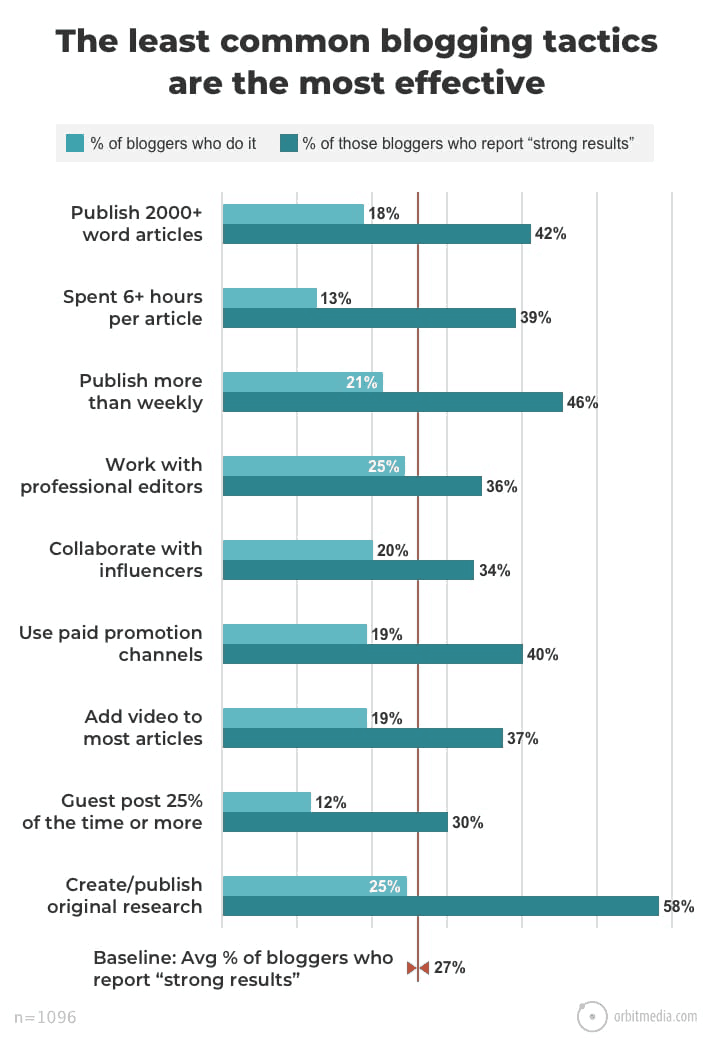SaaS (software as a service) and content marketing have a few key things in common: they’re both overcrowded, oversaturated, and oligopoly markets.
In other words, the (few) rich SaaS businesses at the top (giants like HubSpot, Buffer, etc.) continue to expand their wealth, both metaphorically and literally. They dominate user reach and content rankings, leaving crumbs for the rest of us to fight over.
As you can imagine, and have likely experienced yourself, scaling content and therefore scaling your SaaS business is an uphill battle. You need your content to rank high to drive traffic and brand awareness, but it’s increasingly difficult to climb the ladder, as keywords with even a minuscule volume are hoarded by sites with the highest performing domains.
You need more content. Better content. But you probably can’t spend $50 grand on it yet, either.
In this post, I’ll share two key lessons I learned about scaling content while serving as the head of content strategy at Codeless, a startup that’s grown from nothing to $70,000 in monthly recurring revenue in less than one year.
EXCLUSIVE FREE TRAINING: Successful Founders Teach You How to Start and Grow an Online Business
Scaling Content Requires Better Content
If you think you can just churn out some 1,000-word blog posts and call it a day, you are sorely mistaken.
Scaling content requires better content. Otherwise, you are left with a blog that’s full of mediocre content generating zero traffic and likely negatively impacting your brand perception. And the bar for quality content is getting higher by the day.
SERPs (search engine results pages) for keywords with just 250 monthly searches look like this:
This is the SERP overview for “international SEO,” showing the exact websites that rank for this term along with the domain rating (DR) of each.
The domain rating showcases the strength of a website’s backlink profile, in other words, higher domain ratings mean that the site has more links from better sources.
Having a high DR helps you rank faster, as Google sees your website as an authoritative, trustworthy source of information.
And each one of those posts contains thousands of words, perfect formatting, and a wide variety of sub-topics. Standard content won’t cut it. Studies show this time and time again.
Case in point—we conducted a study at Codeless, where we tested the most popular content writing services.
The results? They were producing mediocre (at best) content that didn’t come close to the content of our competitors for the keywords we’re targeting:
Another recent study by Orbit Media found similar results. The more you put into your content, the better the results:
The least common blogging tactics are the most effective.
Doing more work and putting in more effort is what generates results these days. If you want to scale content at your startup, it has to be strategically planned. It has to be better than your competition. And this means one thing: you can’t “blitz” the market.
Lesson 1: Hire to Train Not to Blitz
When looking to scale your content for your startup, it’s tempting to fall into the trap of blitzing.
This means trying to produce dozens and dozens of pieces of content for all of your target keywords, as fast as possible. Because we all want rankings overnight.
Sadly, it doesn’t work like that. And you’ll end up spending money that generates close to nothing in return.
Because content requirements (length, research, stats, visuals, topics, depth, etc) are so advanced, attacking the market with a high number of posts results in one of two scenarios:
- It becomes way, way too expensive to do as a startup
- You sacrifice quality for quantity
At Codeless, I learned this the hard way. At first, we put out job listings for writers to help scale content, thinking that more was better. We got almost 3,000 applications in a short time, even with more than half being auto-filtered out by those who couldn’t follow the directions.
Most of them were complete junk.
Some of them were decent.
Very few were stellar.
Thinking immediately that we needed top-of-the-line content fast, we went to hire top-of-the-line writers to help scale our content capacity and ensure posts were 99/100 quality.
That resulted in us hiring two people, both of whom were senior content writers with an established, proven history. They were excellent writers. But, they cost a small fortune relative to what we were generating.
Conversely, we tried the blitz approach and hired dozens of freelancers. One or two of them turned work in on time, while the rest couldn’t meet deadlines.
That’s when we found the middle ground. The writers who were proficient in writing and grammar but weren’t marketing superstars.
Instead of spending a $100,000 budget on a single top-of-the-market writer, we went with a different method: Scaling our content by hiring to train.
Build Your Strategy on Systems and Processes
The key to hiring to train is to systemize everything. From day one. That means everything from how to write headlines to post structure to research tutorials. Every little detail should be documented, even how to format the article and where to send it when it’s complete.
Because our writers were great at writing, in general, we didn’t have to teach that. And because they weren’t industry superstars, we weren’t paying a premium to hire them.
But because of this, we had to train them on how to develop posts that were both amazing to read and informative. With a good mar-tech stack, doing so is far easier than you’d think.
Using Pipefy, we build out an entire pipeline of steps in the process, from researching to post-production:
Within each process, we listed the exact steps that a writer needed to take to complete that given step:
This way, no matter who we hired, we could teach them to standardize the process of content production without holding their hand. This leads to top-quality content with less back and forth. Less editing. And more winning.
Each step is systemized:
- Researching a good, less saturated topic
- Finding the most common tactics people list
- Applying their own critical thinking + our documented marketing strategies to improve/create new tactics
- Finding the latest studies and developing strategies based on their findings
- Reading hours of articles per week to learn more about their topics
- Putting them in real-world marketing situations to find solutions
- Compiling all of that into something digestible (2,000-ish words)
- Polishing it
- Publishing it
Taking it further, we established training courses and tests in Trainual, too:
Here we compiled detailed specifics, including screen-grabs, videos, and audio information.
Using systems and processes, anyone we hire to scale content can learn to produce good marketing research and write about it, too. This also allows you to own your angle.
You don’t need to be the next Rand Fishkin.
You don’t need to be Neil Patel.
You don’t need 12 years of experience for the biggest brands in the world to provide marketing insights anymore. Marketing tactics come and go every few months. It’s not a fight for seniority. Instead, it’s a fight for new ideas, creative delivery, and strategic impact.
And that’s exactly how we approached it—who can write without making us fall asleep but also communicate fresh ideas that are backed by data and hands-on experience?
Now, we have all of our current and new writers spending hours per week doing research, reading articles, and learning, not just writing. That’s because writing is half the battle. Having experience and knowledge to back it up is key, too.
During this time, our writers are still getting paid for their time within the training process. In the long run, it’s still far cheaper than paying a top-of-the-line content creator. Why? More writers = more volume = more verticals they can cover (marketing, tech, finance, etc).
While not directly delivering a profit, that time spent learning is critical for growth. You need writers who are willing to learn. To get their hands dirty on a PPC campaign so they can truly provide insights. You don’t want writers who think they know it all. Those are the same writers sharing ideas that are five years outdated or beaten to a pulp.
You need writers who are passionate about learning new things. And that means you helping them spend hours each week reading marketing content to learn both style and strategy.
The bottom line is:
Hiring to blitz can work if you have the budget. But chances are, your startup doesn’t. And to compete in crowded SERPs, you’ll need content that you can’t afford. To make up for it, process and systemize everything you can to teach solid, more entry-level writers how to become better at both marketing and writing in the process.
Lesson 2: Build Partnerships As Fast As Possible
There are four million blog posts published per day now. When you have no domain authority, you need more than just superb content. You need people who can amplify that content on social. You need people who can mention your content in their own content.
Google experts confirmed that content and backlinks are the two most important ranking signals. This means that you can’t just produce awesome content. You also need awesome people to link to that awesome content.
Enter: forming partnerships.
Partnerships are everything when it comes to scaling SaaS content at a startup. They help you increase your domain authority fast, while also driving relevant traffic to your site. In turn, your content strength increases, allowing you to cover more topics in your niche.
Without partners, you’ll be forced to run outreach campaigns that you can’t afford. And who knows if those will generate any returns.
But how do you build networks with partners when you don’t have much to give?
There are a few key ways:
- Former clients/contacts from a previous venture: These are the low-hanging fruit. The easy connections that you likely already have or can re-establish.
- Connect with like-minded people on social: This takes longer but can bring about high-quality relationships.
- Guest posts: Guest posting isn’t meant for links. And if you’re doing that, you could be penalized. Guest posts serve to connect you with new audiences, and more importantly, like-minded people spearheading popular blogs in your niche.
- Interview people: Reach out to bloggers, writers, and marketers that you follow and genuinely enjoy. Don’t be fake. And don’t do it just because you think they can help you. Interview them or podcast with them to inspire your audience and to build a connection with them.
- Get out of the house: Co-working spaces are some of the best places to meet people. Yeah, I know, leaving the house isn’t always fun. But co-working spaces are often packed with entrepreneurs and thought leaders waiting to connect with more people.
Beyond these five that we employed at Codeless, there are likely hundreds of other ways to generate partners. But the best ways have one thing in common: They allow you to generate long-lasting friendships with people where neither party gets used or taken advantage of.
There are no hacks for building partnerships. They arise out of mutual interests and reciprocation.
Spend time connecting with people on a real, human-level and the partners will come naturally to help you scale your own business as you help theirs.
EXCLUSIVE FREE TRAINING: Successful Founders Teach You How to Start and Grow an Online Business
Scaling SaaS Content Marketing is Doable
Scaling content, in general, is tough. You have to ensure your content is stellar, and most of all, consistent. Doing all that with a next to nothing budget as a startup is even worse.
Instead of attacking full force with mediocre content or publishing one expensive post per month, play the middle-ground:
Hire to train. Find proficient writers who lack industry experience and train them to learn and research in your niche. Then, hammer it home with partnerships to help you grow and drive links that your brand needs.
What are some of the best ways you have scaled SaaS content marketing on a low budget?






















